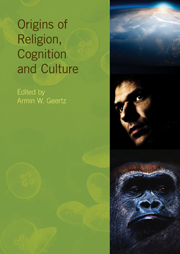Book contents
- Frontmatter
- Contents
- Contributors
- Introduction
- Part I EVOLUTIONARY SCENARIOS
- 1 Whence religion? How the brain constructs the world and what this might tell us about the origins of religion, cognition and culture
- 2 Why “costly signalling” models of religion require cognitive psychology
- 3 The prestige of the gods: evolutionary continuities in the formation of sacred objects
- 4 The evolutionary dynamics of religious systems: laying the foundations of a network model
- 5 Art as a human universal: an adaptationist view
- 6 The significance of the natural experience of a “non-natural” world to the question of the origin of religion
- 7 Religion and the emergence of human imagination
- 8 The origins of religion, cognition and culture: the bowerbird syndrome
- 9 The will to sacrifice: sharing and sociality in humans, apes and monkeys
- 10 Apetales: exploring the deep roots of religious cognition
- Part II COGNITIVE THEORIES
- Index
7 - Religion and the emergence of human imagination
from Part I - EVOLUTIONARY SCENARIOS
- Frontmatter
- Contents
- Contributors
- Introduction
- Part I EVOLUTIONARY SCENARIOS
- 1 Whence religion? How the brain constructs the world and what this might tell us about the origins of religion, cognition and culture
- 2 Why “costly signalling” models of religion require cognitive psychology
- 3 The prestige of the gods: evolutionary continuities in the formation of sacred objects
- 4 The evolutionary dynamics of religious systems: laying the foundations of a network model
- 5 Art as a human universal: an adaptationist view
- 6 The significance of the natural experience of a “non-natural” world to the question of the origin of religion
- 7 Religion and the emergence of human imagination
- 8 The origins of religion, cognition and culture: the bowerbird syndrome
- 9 The will to sacrifice: sharing and sociality in humans, apes and monkeys
- 10 Apetales: exploring the deep roots of religious cognition
- Part II COGNITIVE THEORIES
- Index
Summary
Introduction
Relating the emergence of religion directly to single minds has grown hopelessly out of fashion, and even though the cognitive science of culture delves deep into the human brain, we recognize that religions are first and foremost socially negotiated phenomena. All religious ideas, however, must first surface somehow. At some point in evolutionary history, an ancestor or close relative to the human race had the first proto-religious idea. We have no way of knowing what the content of this thought might have been, what part of life in the Pleistocene inspired it, or if this “first believer” ever shared it with others of his kind. What we do have, however, are advances in cognitive science and evolutionary psychology that allow us to venture certain guesses about what kind of mind may have afforded this first religious thought, a mind so powerful and playful that it grabbed bits and pieces out of thin air, to create a marvel of its own devising. Imagination had entered the scene, and the world would never be the same again …
Imagery and make-believe are words commonly used by critics of religion. Many aspects of ritual involve object substitutions and juggling of facts, which we know well from fiction and children's play. The abilities to embrace stories or be carried away by mystical experiences are hallmarks of spirituality all over the world.
- Type
- Chapter
- Information
- Origins of Religion, Cognition and Culture , pp. 160 - 177Publisher: Acumen PublishingPrint publication year: 2013

